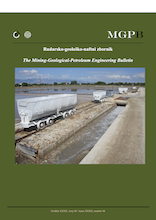Analysis of pedological factors and USCS in the contact area of Đakovo loess plateau and Dilj gora, Croatia
DOI:
https://doi.org/10.17794/rgn.2020.1.2Keywords:
USDA soil classification, USCS, soil mechanics, fuzzy logic, cross-country mobilityAbstract
The pedological factors concerning the Unified Soil Classification System (USCS) in the contact area of Đakovo loess plateau and Dilj gora have been explored. The study was carried out to create a cross-country mobility map for vehicles. The spatial GIS analysis included soil units of Basic Soil Map (BSM) at a scale of 1:50000, which, according to the World Reference Base (WRB), contain within themselves the distribution of soil units, particle size distribution according to the United States Department of Agriculture (USDA) soil classification and organic content, as well as data from the Basic Geological Map (BGM) at a scale of 1:100000, together with the information on the original parent material from which the soils originate. Field sampling (72 samples) and laboratory sample analysis were performed according to the USCS. The samples were collected at the same locations (50 samples) as the profiles which had been extracted during the de- velopment of BSM to enable a comparison of the two classification systems. The analysis did not confirm a clear statisti- cal connection between the USDA and USCS. The compatibility of BSM pedological units and low plasticity clays (CL) is clearly visible in all units, except for the units located on the alluvium. The presence of low plasticity clay (CL) and high plasticity clay (CH) has been confirmed in the stagnosols on the alluvium. By incorporating the geological basis into the spatial analysis, low plasticity clays were found to belong to the Quaternary source material, whereas high plasticity clays were formed on the parent substrate of Neogene age. Data analysis and cartographic representation of the results accord- ing to the Waterways Experiment Station (WES) Method of the cone index were obtained using fuzzy logic. The princi- ples of fuzzy logic were used at the boundaries of pedological units due to the inability to define clear boundaries or the cessation of a particular type of soil’s presence.
Downloads
Published
How to Cite
Issue
Section
License
Copyright (c) 2019 authors and journal

This work is licensed under a Creative Commons Attribution 4.0 International License.
Creative Commons-BY
Authors who publish with this journal agree to the following terms:
In agreeing this form, you certify that:
- You read the ethical codex of the RGN zbornik available at journal web.
- You submitted work is your original work, and has not previously been published and does not include any form of plagiarism.
- You own copyright in the submitted work, and are therefore permitted to assign the licence to publish to RGN zbornik.
- Your submitted work contains no violation of any existing copyright or other third party right or any material of an obscene, libellous or otherwise unlawful nature.
- You have obtained permission for and acknowledged the source of any illustrations, diagrams or other material included in the work of which you are not the copyright owner.
- You have taken due care to ensure the accuracy of the work, and that, to the best of your knowledge, there are no false statements made within it.
- All co-authors of this submitted work are aware of, and in agreement with, the terms of this licence and that the submitted manuscript has been approved by these authors.
Publication licence
You retain copyright in your submitted work, according to journal license policy (CC-BY). By signing this form you agree that RGN zbornik may publish it under the publication licence. In summary the licence allows the following:
Anyone is free:
- To copy, distribute, display, and perform the work.
- To make derivative works.
Under the following conditions:
- The original author must always be given credit.
- The work may not be used for commercial purposes.
- If the work is altered, transformed, or built upon, the resulting work may only be distributed under a licence identical to this one.
Exceptions to the licence
In addition to publishing the work printed under the above licence, RGN zbornik will also enable the work to be visible online.
The journal editorial can change the licence rules anytime but it cannot retroactively restrict author(s) rights.


